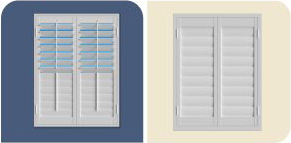
3 Ways Polywood Shutters Are A Better Choice Than Hollow Vinyl And Composite Shutters In Hartford, CT
December 15, 2015
The market for plantation shutters in Hartford is full of options. And when you want to know which non-wood shutter fits your home best, it’s not easy to distinguish the differences. You can pick the wrong type without knowing and end up purchasing low quality shutters. When it comes to solid polymer shutters, like our best-selling Polywood® shutters, are they a better value than hollow vinyl or MDF (multi-density fiberboard) shutters? Find out the three ways Polywood shutters are a better choice than composite shutters in Hartford, CT to help you decide.
1. Polywood vs Composite Shutters Durability
Polywood shutters are fashioned from a first class solid polymer that leads to the most rigidity, color-retention, and durability than any other shutter available. This means the shutter louvers won't be damaged as long as they’re on the window. In contrast, composite shutters are made from a pressed-board core, enveloped in poly-vinyl. The vinyl wrapping the pressed board also peels away from the core material easily. And this peeling is expedited in hot, humid, and wet environments. Hollow vinyl shutters are another option for non-wood shutters. But they disintegrate the fastest in large part due to the substance.Both types of non-wood shutters are vulnerable to warping and deterioration when exposed to the different environmental conditions in Hartford. Polywood is manufactured with UV inhibitors that deflect heat. And because heat is the main culprit in splitting the shutter louvers, Polywood is hands down the longest lasting plantation shutter for your home.
2. Polywood vs Composite Shutters Color Fastness
Polywood shutters are available in three premium white paints. We bake these paint finishes on each piece at hot temperatures that exceed any temperatures Hartford could experience. This patented finishing process includes UV inhibitors to ensure the color doesn’t fade.
Other types of non-wood shutters come with either low quality paint finish or no paint finish at all. In a lot of cases, the vinyl layer is the final color. This finish may look good initially, but it fades as time goes by. And as to hollow vinyls, some are painted. However, with the material easily conducting heat, this adversely influences the finish as time goes by.
3. Polywood vs Composite Shutters Energy Efficiency
Third party tests show that Polywood shutters insulate against 30° of temperature and reduce heat transfer by up to 45%. That’s how Polywood insulates up to 70% better than even the best solid wood shutter.
Polywood’s insulating properties are a result of the solid polymer material. But what makes Polywood even more energy efficient than composite shutters is the weatherstripping on louvers and panels. All you have to do is interlock the pieces of weatherstripping while closing the panels and you get an airtight seal against the effects of the weather outside. You won’t find all the energy savings that Polywood offers in any composite shutter.
The Sunburst Team In Vegas Puts The Durability Of Polywood Shutters To The Test
In 2004, Sunburst Shutters Las Vegas had Polywood shutters fastened to the sides of their trucks as part of the graphics. These trucks were parked outside and saw the weather Nevada is infamous for. That’s intense heat for five months out of the year!
The plantation shutters had been on our company trucks for almost 7 years at that point. Our team conducted an investigation on the color retention value of Polywood. The team wiped down the dusty Polywood shutter installed on the vehicle. And we compared it side by side to a new Polywood. We found the color to be unchanged. There wasn’t any visible signs of fading or discoloration. This was further validation for us that this paint finish is the best in the market!
And since Polywood can endure all that abuse and heat on the side of a truck for more than 7 years, it’s undoubtedly the most durable shutter for your residence in Hartford, CT.


